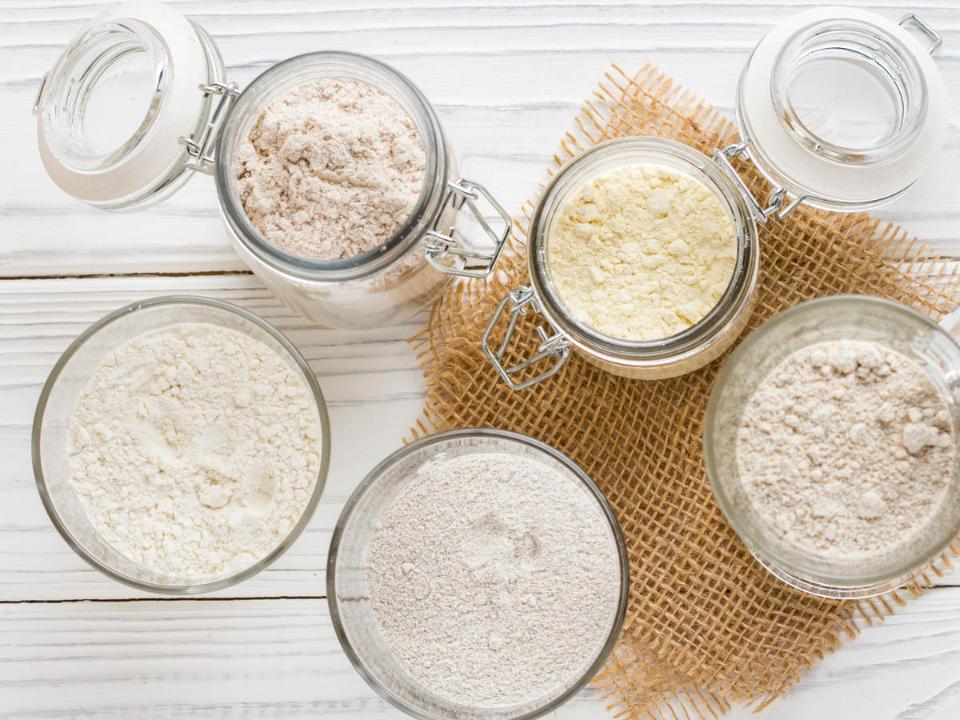
The type of flour you use in your baking can greatly affect the outcome of your cakes, cookies and pies, so it helps to know what you’re working with.
Flour is made from grinding wheat (duh). The seed head, or the part of the wheat plant that gets ground, is made up of 3 parts: the endosperm, the bran and the germ. A flour labeled “whole wheat” is made from all three parts, while a white flour is made only from the endosperm, which makes it more shelf stable and tender. It’s difficult for whole wheat flours to develop the same level of gluten as non-whole wheat, which is why baked goods made with whole wheat tend to be more dense than those made with white flour.
Protein content determines how much gluten the flour will form, which in turn affects the textural quality of your baked good. Flours with a high protein content create more gluten (which provides a strong and dense structure), and those with a lower protein content form less gluten (lower protein and less gluten gets you light and airy structure; think ‘LLL’ for Lower protein. Less gluten. Light texture.). Let’s take a closer look at each of these four flours, from high to low protein content, and chat about best uses and substitutions.
All-Purpose Flour
All-purpose flour is made with only the endosperm, which makes it more shelf-stable than flours made from grinding the whole seed head. It has less fiber and protein than a whole-wheat flour, but it’s great for middle-of-the-road baked goods that aren’t particularly delicate, like cookies, brownies and quick-breads.
This is the flour you probably know very well and (unless you are gluten-intolerant) likely love. Made from a blend of high-gluten hard wheat and low-gluten soft wheat, it’s terrific for everything from our favorite Buttermilk Pancakes, Sugar Cookies, and Classic Chocolate Layer Cake, to dredging chicken for Oven Baked Chicken Tenders or Hot Chicken Tacos with White Slaw Sauce, and more.
All-purpose flour (or AP Flour, as it’s known in chef speak) is a fine-textured flour with an approximate protein content of 10 to 12 percent. This flour comes in two forms, bleached (which is flour that is bleached by a chemical process) and unbleached (which is flour that is actually bleached, but it’s bleached naturally as it ages). Generally speaking, recipes that call for all-purpose flour are best made with such. If you happen to have leftover bread flour, you can use bread flour in place of AP flour (at a 1:1 ratio), for yeast doughs, like the ones mentioned under Bread Flour above.
Bread Flour
Bread flour is made out of “hard wheat” varieties, which give it a higher protein content. That protein content leads to better gluten development, which is useful in anything that is supposed to come out chewy and textural, like bread or bagels. Avoid using bread flour in anything that is supposed to be tender, like cakes and pastries.
With a protein content of approximately 14 to 16 percent, this high-gluten flour is a blend of 99.8 percent hard-wheat flour with a touch of malt barley added to improve yeast activity, plus vitamin C or potassium bromate, which increases gluten’s elasticity. In short, it’s your go-to flour for yeast breads, which are breads that use yeast as a leavening agent (brioche, croissant, French bread and sourdough, for example).
Can you substitute all-purpose flour for bread flour (and vice-versa)? Yes, you can absolutely make a 1:1 substitute. For 1 cup bread flour, use 1 cup all-purpose, and vice-versa (note breads and pizza crusts made with all-purpose flour may have a little less chew than those made with bread flour, but results will still be good). If you want to try using bread flour as a substitute for all-purpose flour in recipes for yeast doughs that call for all-purpose flour, your breads and pastries will get a welcome extra little lift. You can try using bread flour as a substitute for all-purpose in our No-Knead Onion Rolls, Basil Beer Bread, or Foolproof Whole Wheat Bread.
Pastry Flour and Cake Flour
While these two flours aren’t exactly the same, they are both fine-textured soft flours with a low protein content (pastry flour clocks in at approximately 9 percent protein, while cake flour is even lower, with a protein content of about 7 to 8 percent). These flours have just enough protein to give structure to cakes and other tender-crumbed baked goods, while keeping texture deliciously airy and light.
In a pinch you can pretty easily and successfully substitute AP flour for cake flour and for pastry flour, by using this ratio: For every 1 cup cake or pastry flour called for in a recipe, measure 1 cup of AP flour, then remove 2 tablespoons (this will leave you with 7/8 cup of AP flour, also known as a scant cup, which you can alternatively measure by eye). Add 2 tablespoons cornstarch to your scant cup of AP flour and, poof!, you’re good to go.
Cake Flour
Cake flour is the most finely milled flour you’ll find, with a similar level of protein content to pastry flour. It is almost always bleached, which contributes to its ability to bake to a very high rise. Use it in places where a highly-risen, tender result is desired, like sponge cakes.
Pastry Flour
Pastry flour is milled to a finer texture than all-purpose flour, and is made with soft wheat for a lower protein content, which helps baked goods like pie crusts and pound cake recipes produce very tender results and a fine crust. Avoid using pastry flour for anything that demands structure, like bread doughs or pastas.
Bonus: Bleached vs. Unbleached
Bleached flours are treated with chemicals like chlorine or benzoyl peroxide, that damages the starch and protein content. It is generally easier to work with, absorbs more liquid, and rises better than unbleached flour. Most types of white flour are available bleached or unbleached.